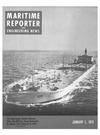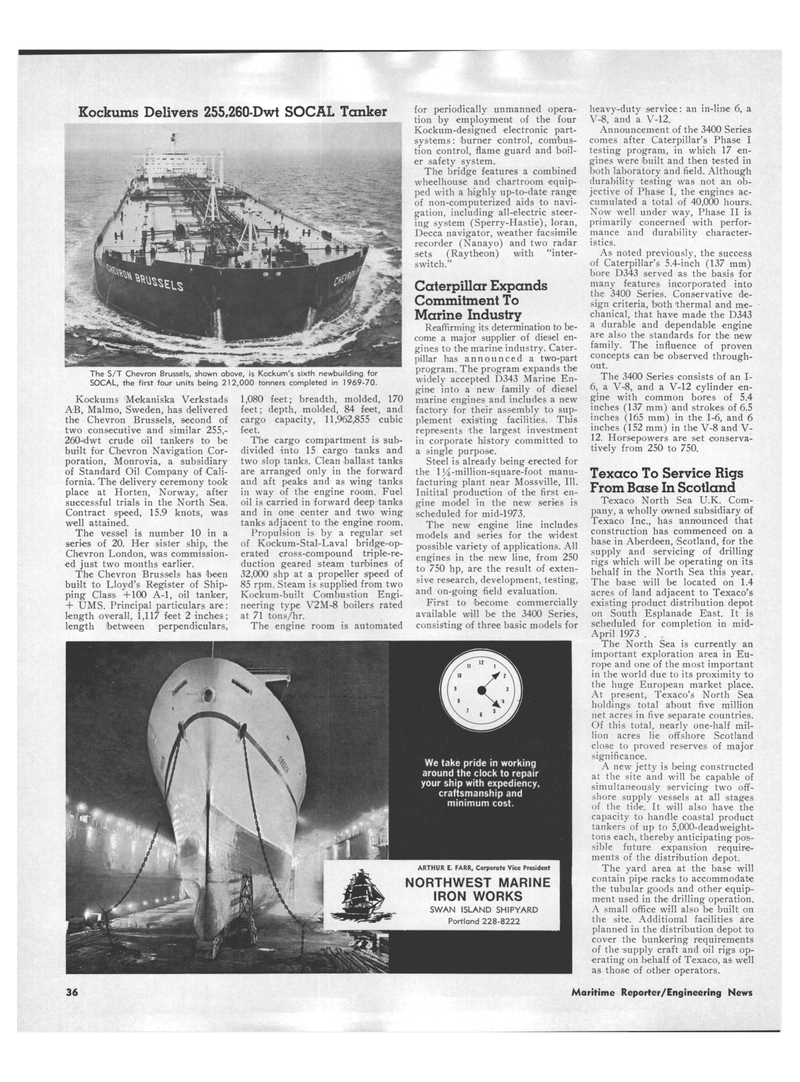
Page 34: of Maritime Reporter Magazine (January 1973)
Read this page in Pdf, Flash or Html5 edition of January 1973 Maritime Reporter Magazine
We take pride in working around the clock to repair your ship with expediency, craftsmanship and minimum cost.
ARTHUR E. FARR, Corporate Vice President
NORTHWEST MARINE
IRON WORKS
SWAN ISLAND SHIPYARD
Portland 228-8222 36 Maritime Reporter/Engineering News
Kockums Delivers 255,260-Dwt SOCAL Tanker
The S/T Chevron Brussels, shown above, is Kockum's sixth newbuilding for
SOCAL, the first four units being 212,000 tonners completed in 1969-70.
Kockums Mekaniska Verkstads
AB, Malmo, Sweden, has delivered the Chevron Brussels, second of two consecutive and similar 255,- 260^dwt crude oil tankers to be built for Chevron Navigation Cor- poration, Monrovia, a subsidiary of Standard Oil Company of Cali- fornia. The delivery ceremony took place at Horten, Norway, after successful trials in the North Sea.
Contract speed, 15.9 knots, was well attained.
The vessel is number 10 in a series of 20. Her sister ship, the
Chevron London, was commission- ed just two months earlier.
The Chevron Brussels has 'been built to Lloyd's Register of Ship- ping Class +100 A-l, oil tanker, + UMS. Principal particulars are: length overall, 1,117 feet 2 inches; length between perpendiculars, 1,080 feet; breadth, molded, 170 feet; depth, molded, 84 feet, and cargo capacity, 11,962,855 cubic feet.
The cargo compartment is sub- divided into 15 cargo tanks and two slop tanks. Clean ballast tanks are arranged only in the forward and aft peaks and as wing tanks in way of the engine room. Fuel oil is carried in forward deep tanks and in one center and two wing tanks adjacent to the engine room.
Propulsion is by a regular set of Kockum-Stal-Laval bridge-op- erated cross-compound triple-re- duction geared steam turbines of 32,000 shp at a propeller speed of 85 rpm. Steam is supplied from two
Kockum-built Combustion Engi- neering type V2M-8 boilers rated at 71 tons/hr.
The engine room is automated for periodically unmanned opera- tion by employment of the four
Kockum-designed electronic part- systems: burner control, combus- tion control, flame guard and boil- er safety system.
The bridge features a combined wheelhouse and chartroom equip- ped with a highly up-to-date range of non-computerized aids to navi- gation, including all-electric steer- ing system (Sperry-Hastie), loran,
Decca navigator, weather facsimile recorder (Nanayo) and two radar sets (Raytheon) with "inter- switch."
Caterpillar Expands
Commitment To
Marine Industry
Reaffirming its determination to be- come a major supplier of diesel en- gines to the marine industry. Cater- pillar has announced a two-part program. The program expands the widely accepted D343 Marine En- gine into a new family of diesel marine engines and includes a new factory for their assembly to sup- plement existing facilities. This represents the largest investment in corporate history committed to a single purpose.
Steel is already being erected for the 154-million-square-foot manu- facturing plant near Mossville, 111.
Initital production of the first en- gine model in the new series is scheduled for mid-1973.
The new engine line includes models and series for the widest possible variety of applications. All engines in the new line, from 250 to 750 hp, are the result of exten- sive research, development, testing, and on-going field evaluation.
First to become commercially available will be the 3400 Series, consisting of three basic models for heavy-duty service: an in-line 6, a
V-8, and a V-12.
Announcement of the 3400 Series comes after Caterpillar's Phase I testing program, in which 17 en- gines were built and then tested in both laboratory and field. Although durability testing was not an ob- jective of Phase I, the engines ac- cumulated a total of 40,000 hours.
Now well under way, Phase II is primarily concerned with perfor- mance and durability character- istics.
As noted previously, the success of Caterpillar's 5.4-inch (137 mm) bore D343 served as the basis for many features incorporated into the 3400 Series. Conservative de- sign criteria, both thermal and me- chanical, that have made the D343 a durable and dependable engine are also the standards for the new family. The influence of proven concepts can be observed through- out.
The 3400 Series consists of an I- 6, a V-8, and a V-12 cylinder en- gine with common bores of 5.4 inches (137 mm) and strokes of 6.5 inches (165 mm) in the 1-6, and 6 inches (152 mm) in the V-8 and V- 12. Horsepowers are set conserva- tively from 250 to 750.
Texaco To Service Rigs
From Base In Scotland
Texaco North Sea U.K. Com- pany, a wholly owned subsidiary of
Texaco Inc., has announced that construction has commenced on a base in Aberdeen, 'Scotland, for the supply and servicing of drilling rigs which will be operating on its behalf in the North Sea this year.
The base will be located on 1.4 acres of land adjacent to Texaco's existing product distribution depot on South Esplanade East. It is scheduled for completion in mid-
April 1973 .
The North Sea is currently an important exploration area in Eu- rope and one of the most important in the world due to its proximity to the huge European market place.
At present, Texaco's North Sea holdings total about five million net acres in five separate countries.
Of this total, nearly one-half mil- lion acres lie offshore Scotland close to proved reserves of major significance.
A new jetty is being constructed at the site and will be capable of simultaneously servicing two off- shore supply vessels at all stages of the tide. It will also have the capacity to handle coastal product tankers of up to 5,000-deadweight- tons each, thereby anticipating pos- sible future expansion require- ments of the distribution depot.
The yard area at the base will contain pipe racks to accommodate the tubular goods and other equip- ment used in the drilling operation.
A small office will also be built on the site. Additional facilities are planned in the distribution depot to cover the bunkering requirements of the supply craft and oil rigs op- erating on behalf of Texaco, as well as those of other operators.

 33
33

 35
35
